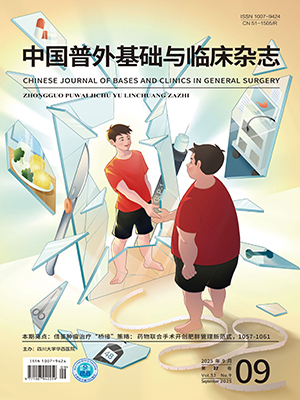| 1. |
尚东, 张庆凯. 腹腔镜胆囊切除术胆管损伤的预防. 中华普通外科杂志, 2017, 32(8): 654-657.
|
| 2. |
Hariharan D, Psaltis E, Scholefield JH, et al. Quality of life and medico-legal implications following iatrogenic bile duct injuries. World J Surg, 2017, 41(1): 90-99.
|
| 3. |
李相成, 江王杰. 医源性胆管损伤分型及其意义. 中国实用外科杂志, 2018, 38(9): 985-988.
|
| 4. |
刘希宁, 李英俊, 张瑞波, 等. 腹腔镜胆囊切除术中胆管损伤的处理方法探讨. 中华普通外科学文献(电子版), 2018, 12(6): 397-399, 404.
|
| 5. |
Barrett M, Asbun HJ, Chien HL, et al. Bile duct injury and morbidity following cholecystectomy: a need for improvement. Surg Endosc, 2018, 32(4): 1683-1688.
|
| 6. |
王红伟, 刘江伟, 康燕, 等. 微创保胆治疗1 008例胆囊息肉的临床及病理分析. 中国普外基础与临床杂志, 2018, 25(9): 1065-1070.
|
| 7. |
尚培中. 胆囊结石腹腔镜治疗今日观. 解放军医药杂志, 2015, 27(11): 1-5.
|
| 8. |
尚培中. 腹腔镜胆囊切除术中胆囊壶腹钟表定位法的研究及应用分析. 人民军医, 2017, 60(11): 1088-1091.
|
| 9. |
尚培中. 胆囊壶腹钟表定位法对保障腹腔镜胆囊切除安全性的指导意义. 中华普外科手术学杂志(电子版), 2018, 12(1): 15-20.
|
| 10. |
尚培中, 李晓武, 苗建军, 等. 应用壶腹钟表定位法缩短腹腔镜胆囊切除术学习曲线. 腹腔镜外科杂志, 2018, 23(7): 481-485.
|
| 11. |
Wakabayashi G, Iwashita Y, Hibi T, et al. Tokyo Guidelines 2018: surgical management of acute cholecystitis: safe steps in laparoscopic cholecystectomy for acute cholecystitis (with videos). J Hepatobiliary Pancreat Sci, 2018, 25(1): 73-86.
|
| 12. |
项建斌. 早期腹腔镜胆囊切除术治疗轻中型急性胆囊炎的临床研究. 中华普外科手术学杂志(电子版), 2019, 13(1): 54-56.
|
| 13. |
彭一峰, 莫晔, 陈国斌, 等. 腹腔镜胆囊动脉入路与传统入路胆囊切除术的对比分析. 中华普外科手术学杂志(电子版), 2018, 12(2): 152-154.
|
| 14. |
齐敦峰, 张昕辉, 李欢送, 等. 腹腔镜下左侧入路胆囊切除术在急性胆囊炎患者中的应用. 中国普外基础与临床杂志, 2017, 24(12): 1492-1495.
|
| 15. |
李晓东, 刘山, 郑本波. 4种解剖标志帮助识别胆囊管避免胆管损伤(附316例报道). 中国普外基础与临床杂志, 2018, 25(9): 1121-1123.
|
| 16. |
戴海粟, 陈志宇. 肝门部解剖变异与腹腔镜胆囊切除术中胆管损伤. 中华普通外科杂志, 2017, 32(8): 661-664.
|
| 17. |
王蔚蓝, 吴伟, 吕永峰, 等. 腹腔镜胆囊切除术中变异胆囊动脉出血的预防与处理. 中国微创外科杂志, 2014, 14(6): 551-552.
|
| 18. |
闫志文, 闫文举. 腹腔镜胆囊切除术中胆囊动脉出血的原因及防治措施. 医药论坛杂志, 2014, 35(12): 104-105.
|
| 19. |
黄鑫, 洪建文, 詹泽锋, 等. 腹腔镜胆囊切除术中转开腹30例临床分析. 中华肝脏外科手术学电子杂志, 2014, 3(5): 276-278.
|
| 20. |
孟凡盛, 庞晨, 高原, 等. 胆囊管和胆囊动脉的变异分型及影像辅助检查. 世界最新医学信息文摘(电子版), 2017, 17(99): 203-204.
|
| 21. |
赵晓刚, 王德贵. 腹腔镜胆囊切除术中胆囊动脉的解剖观察. 临床医学研究与实践, 2016, 1(14): 89.
|
| 22. |
Kunasani R, Kohli H. Significance of the cystic node in preventing major bile duct injuries during laparoscopic cholecystectomy: a technical marker. J Laparoendosc Adv Surg Tech A, 2003, 13(5): 321-323.
|
| 23. |
张伟耀, 饶智, 潘磊. 胆囊淋巴结在腹腔镜胆囊切除术中的定位标志作用初探. 中国普外基础与临床杂志, 2014, 21(9): 1134-1137.
|
| 24. |
哈恒勇, 陈文学, 李富荣. 腹腔镜" 一钩到底法”快速胆囊切除术的临床应用研究. 中华普通外科学文献(电子版), 2015, 9(4): 304-306.
|
| 25. |
Strasberg SM, Pucci MJ, Brunt LM, et al. Subtotal cholecystectomy—" Fenestrating” vs " Reconstituting” subtypes and the prevention of bile duct injury: definition of the optimal procedure in difficult operative conditions. J Am Coll Surg, 2016, 222(1): 89-96.
|
| 26. |
Stefanidis D, Chintalapudi N, Anderson-Montoya B, et al. How often do surgeons obtain the critical view of safety during laparoscopic cholecystectomy? Surg Endosc, 2017, 31(1): 142-146.
|




